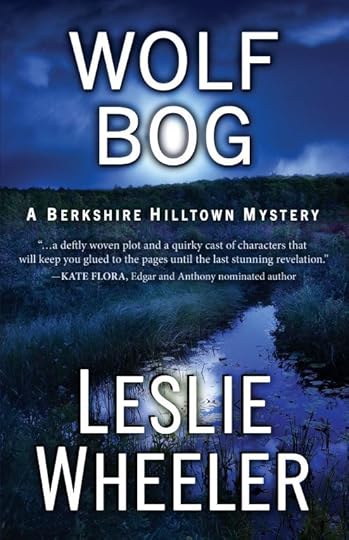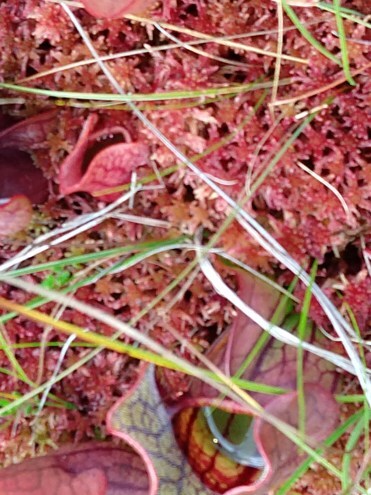Guest Leslie Wheeler – Location, Location, Location plus #giveaway!
Edith/Maddie here, enjoying the start of summer north of Boston.
I’ve known Leslie Wheeler through the New England crime fiction community for many years. She’s a tireless contributor to the New England Crime Bake, to the Al Blanchard short story conference, and to the Sisters in Crime New England chapter. Now she has a new book out in the Berkshire Hilltown Mysteries, one of my favorite series, and one lucky commenter will win an ARC of Wolf Bog!

Here’s the blurb:
In the drought-ridden Berkshires a group of hikers that includes Kathryn Stinson discover the perfectly preserved body of a local teenager, missing for forty years, at Wolf Bog. Who was he and what happened between him and Kathryn’s close friend, Charlotte Hinckley, to make her distraught and blame herself for his death? Searching for answers, Kathryn learns of the fabulous parties held at a mansion up the hill from her, where local teenagers like the deceased mingled with the offspring of the wealthy. Other questions dog the arrival of a woman claiming to be the daughter Charlotte gave up for adoption. But is she really Charlotte’s daughter, and if not, what’s her game? Once again, Kathryn’s quest for the truth puts her in grave danger.
Location Scouting My Mysteries
One of the things I especially enjoy about writing my mysteries is searching for the right places for the action to take place in the same way a location scout does for a movie. For the three books in my Miranda Lewis Living History series, I spent many hours at the various sites where the stories unfold: Plimoth Plantation, a Gettysburg reenactment, and Mystic Seaport (for Murder at Spouters Point). Since my new series is set in the Berkshires, where I have a house, I figured I wouldn’t have to travel very far afield. This was true for the first two books, but not so much the new one, Wolf Bog.
As the title indicates, important action occurs at a bog. There is no bog in my town of New Marlborough, upon which my fictional town of New Nottingham is based. However, there is a Wolf Swamp that’s part of a large area of wetlands and woods known as Thousand Acre Swamp. The idea for the book actually came to me on a hike there with members of the town land trust. As we stood on the shores of East India Pond, looking across the water to the far side where the swamp is, a male voice behind me said, “People have gone in there and never been seen again.”
His words piqued my interest. I knew then I’d probably write about someone who disappears into a swamp, with the difference that my swamp would be a bog, so the victim’s body would be perfectly preserved after many years. In doing so, I thought I could afford to take a little literary license. Still, I felt I needed to visit a real-life bog. An online search led me to the Hawley Bog, just across the border from the Berkshires in Franklin County.
Filled with the spirit of adventure, I set out for Hawley Bog from my home in Southern Berkshire County on a crisp fall day. I drove north to Pittsfield, continuing on until the city and its environs gave way to sleepy small towns and villages, where I sensed little had changed over time. They were replaced by meadows and woodland, with the occasional house plopped down seemingly in the middle of nowhere. The trip from my house to the bog was supposed to take an hour and a half, but the journey through unfamiliar, underpopulated countryside seemed to last longer. Finally, I got on narrow, winding East Hawley Road, which brought me to my destination.

From the parking area, a trail through the woods took me to the entrance of the bog. Before me lay a vast expanse of floating plant matter, mainly sphagnum moss, interspersed with areas of black water, and with a boardwalk stretching into it. My research told me that this was a “quaking bog” because the 30-foot-deep mattress of plant life actually moves! With some trepidation, I stepped onto the boardwalk with my camera and trusty hiking pole. Fortunately, I felt no earthquake-strength tremors that day. Perhaps the bog mat was napping.

Along the way, I noticed some of the carnivorous plants that populate bogs. These plants rely on insects for nourishment, which the highly acidic bog soil, or peat, doesn’t provide. They include the dark purple pitcher plant that lures its insect prey with its brilliant color only to trap and devour it. Bogs are, however, home to more benign plants like orchids and cranberries that can tolerate the acidic soil. And this same acidic soil, composed of layer upon layer of decayed plant matter, has the effect of embalming the bodies that land in it.
As I returned to my car, I said a silent thanks to the Nature Conservancy, which maintains the Hawley Bog, for providing me and many others with a safe means of experiencing this type of wetlands. You’d think I would have stopped there, but not long afterward I felt a strong urge to visit Wolf Swamp itself. No easy feat because the swamp can’t be seen from any of the several trails that crisscross Thousand Acre Swamp. Also, I knew from previous experience that it’s very easy to get lost there. I enlisted the help of a local historian and land trust member to serve as my guide. We followed a trail that got us close to the swamp, but with no view. We then left the trail to bushwhack our way to a place where we could see it, stepping from one fallen tree trunk or boulder to another. Although we never made it to a decent viewpoint, I did have the experience of having my hiking pole sink deep into the soggy ground. That was enough for me. No way was I going to risk being sucked into the quicksand! My guide and I returned to the trail.
Readers: Have you visited a place that you think would make a good setting for a mystery? One of the commentators will receive an ARC of Wolf Bog.

An award-winning author of books about American history and biographies, Leslie Wheeler has written two mystery series. Her Berkshire Hilltown Mysteries launched with Rattlesnake Hill and continue with Shuntoll Road and Wolf Bog. Her Miranda Lewis Living History Mysteries debuted with Murder at Plimoth Plantation and continue with Murder at Gettysburg and Murder at Spouters Point. Her mystery short stories have appeared in numerous anthologies. Leslie is a member of Mystery Writers of America and Sisters in Crime, and a founding member of the New England Crime Bake Committee. She divides her time between Cambridge, Massachusetts, and the Berkshires, where she writes in a house overlooking a pond. Find her at her website.



